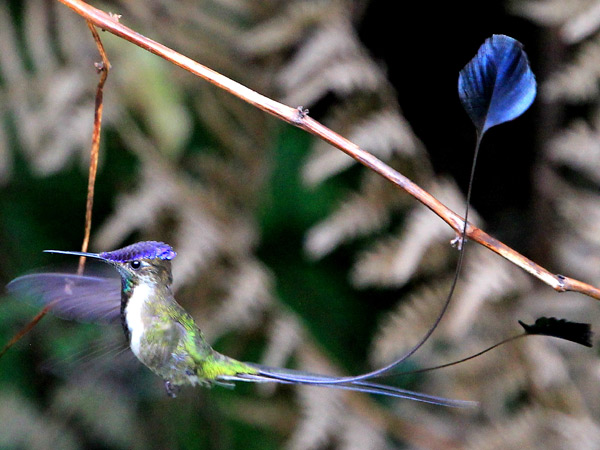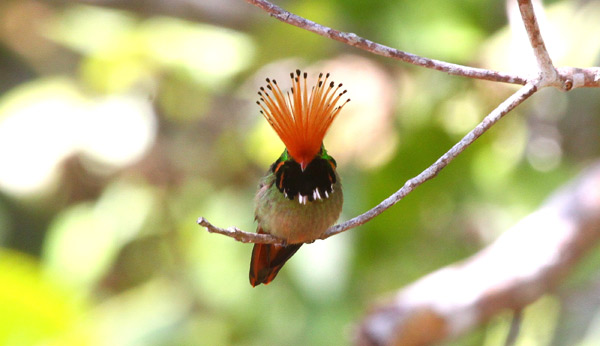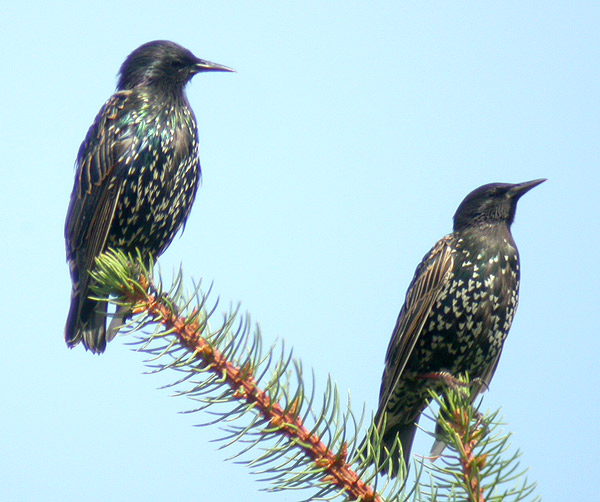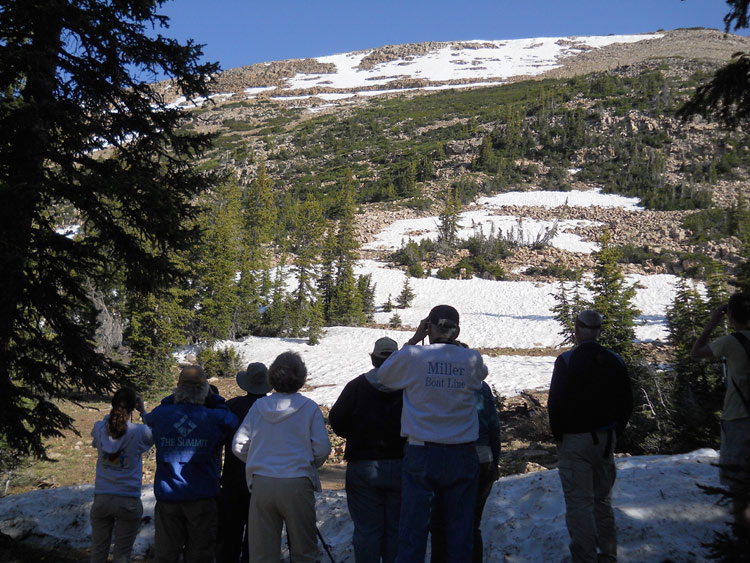Utah County Birders Newsletter
|
 |
Contents
August Meeting
Upcoming Field Trips
President's Message
Bird of
the Month
Field Trip Report - Mirror Lake Highway
Backyard Bird of the Month
July Hotline Highlights
AUGUST MEETING:
Annual Summer Social.
The Summer Social
will be Thursday August 11 at 7 PM at
Rock Canyon Park in
Provo.
We are having a Pot Luck Dinner, so bring something to share. Also bring your
own plate and utensils.
It is always fun to visit with the other birders. Hope to see you there!
Beginning birders are welcome.
August 6th (Sat): 7:00am -
11:00am. Dennis Shirley will lead a field trip up the Nebo
Loop. Meet at 7:00am at the Payson Walmart. We will look for Purple
Martin, Three-toed Woodpecker, and other species at the usual stops along the
Nebo Loop.
August 13th (Sat): 7:00am-afternoon.
Bryan Shirley will lead a field trip to Antelope
Island Causeway to look
for migrating shorebirds and other species. Trip may continue north from there
depending on what is being seen. Meet in the Sam's Club parking lot in Provo
East Bay at 7am.
August 20th (Sat): 6:30am -
9:30am. Eric Huish will lead a field trip around the Provo
Airport Dike. Meet at 6:30am at the Provo River Parkway parking lot
just outside the Utah Lake State Park entrance. Directions - Drive West on
Provo Center Street, right after you cross the Provo River (before Utah Lake
State Park) turn right then immediately turn right again into the parking lot.
August 27th (Sat): 7:00am
until we're done. Wild
Card Field Trip. We will meet at the Provo East Bay Sam's Club
parking lot at 7am. Tentative destination is River Lane in search of early
migrating warblers. However, if migration is slow and there are hot
spots/requests to go elsewhere we may change plans.
We are actively recruiting people to lead local half-day field trips, any time,
any place. If you would like to lead a field trip or if you have any ideas for
this year’s field trips, please contact Keeli Marvel at - keeli.marvel@gmail.com.
by Bryan Shirley, UCB President
Hummingbirds
 |
|
Marvellous Spatuletail by Hideo Tani / www.torihenro.com |
 |
|
Rufous-crested Coquette by Bryan Shirley |
Everybody
that knows me knows I am a birder. If I had a nickel for every time I had to
explain to some unenlightened soul the reason I like to birdwatch I would treat
you all to a cruise to see Emperor Penguins in Antartica. As I am explaining our
hobby, carefully trying to leave out words like lifer or lister, almost every
single time I get asked what my favorite bird is. I think they imagine me
staring though my spotting scope (but of course they called it a telescope) at
my favorite bird for hours on end. I always tell them that I don’t really have a
favorite bird, I like looking for birds, finding new birds, etc, but I don’t
really have a favorite. I might tell them that I do have a favorite group of
birds though, but even that changes frequently. If I have been in Central or
South America lately my favorite family is the Tanagers. After a trip to the
Eastern US it is definitely Warblers. Well, I just got home from Peru and right
now my favorite group is the Hummingbirds.
All of us birders here in Utah are all used to seeing hummingbirds. They are
common throughout our state from spring to fall. Mostly we have 2 species –
Broad-tailed and Black-chinned, but a few of you lucky birders may Rufous and
the very lucky ones might even get a Calliope on occasion. In southern Utah you
might be able to see a couple more species. If you keep on heading south to
South-Eastern Arizona you could see about a dozen species. In my North American
field guide there are 21 species total, including rarities like a Xantus’s.
Cross the border into Mexico and the numbers keep on going up, but any idea how
many of those little hummers there are out there?
The family Trochilidae, or the hummingbirds, has a whopping 335 species give or
take a few depending which book you use. That makes the hummingbirds the third
largest family, behind Tyrannidae (Tyrant Flycatchers) and Psittacidae
(Parrots). They are only found in the western hemisphere, but they are
practically everywhere between Alaska and southern Chile. They live everywhere
from scorching deserts to above 17,000 feet in the mountains, but the greatest
diversity is in the cool and damp cloud forests of the Andes.
In July I was in Northern Peru for about 10 days and we tallied up 36 species of
hummers, 9 of which were new for me. One of them was one of the coolest birds I
have ever seen. It is called the Marvelous Spatuletail. They inhibit a tiny dot
on the map of Peru and are very rare, but thanks to a nice preserve and a few
hummingbird feeders they aren’t that hard to find. We waited and watched the 10
or 12 other species visiting the feeders for about an hour before an adult male
Spatuletail finally flew in. After studying the bird in the field guide I
thought I was ready, but I still couldn’t help but gasp in amazement at its
tail. I still am not sure how this thing can fly around the forest with those
tail feathers. Unfortunately in my dazed state I was unable to get any good
photos, so I had to borrow one from one of the tour participants. The other
picture is another of my favorite birds of the trip and I actually got a picture
of this one so I thought I would include it too.
Now that I am back home I have been watching my feeder dreaming, like I do every
year, of having a Calliope stop in for a drink. He better hurry though, because
pretty soon fall migration will be picking up and then there is a good chance
that my new favorite birds will be the warblers…
Bird of the Month
by Sherry Shadday
 |
|
Photo by Milt Moody |
European Starlings.
Sturnus vulgaris
Living up to their scientific name, starlings are generally considered a
nuisance bird. I have found that the mere mention of their common name can cause
vulgar language to fly about among birders…and among non-birders as well. Again,
living up to their name, European Starlings are not native to North America.
According to history, a Mr. Eugene Schieffelin wanted to introduce all the birds
mentioned in Shakespeare’s works to North America and brought several starlings
over from Europe to be released here, where they flourished.
I knew nothing about starlings until several years ago when a local wild bird
supply store flew into town and set up nest in Layton. We put out backyard
birdfeeders (started with one, but as anyone who is anyone knows, one leads to
another, to another, to another – I think they breed like rabbits) and the birds
passed on the info that there was a new restaurant in town.
Of course, that brought in both the desired and the unsavory. At first, I was
quite intrigued by any new bird that showed up, even the starlings. Then I
realized they have a tendency to eat you out of house and home, like an
unwelcome guest who just refuses to leave. On top of that, they never shut up.
Maybe they are the talk show host of the backyard? Plus I heard all the bad
press – starlings are messy, starlings are bullies, starlings will eat anything
and everything. Great, I thought, too late now. I hadn’t put out the “no
manners, no service” sign and now I can’t get rid of them.
I have since learned to embrace their eccentric ways and appreciate their
beauty. For instance, the way they never look the same: in early winter, they
complete their molt and become covered with white spots (as if trying to
camouflage themselves in falling snow); just in time for spring, the spots have
gradually worn off and the starlings become black with a purplish sheen that
absolutely glows in the sunshine; and by fall, they are starting to dull
somewhat, getting ready for that switch from the prom wear to the stodgy mottled
pajamas of winter. Their long sharp bills also do a transformation: dark in the
winter, sunny yellow in the summer. (Oh, and I read in the 2008 Smithsonian
Field Guide to the Birds of North America that you can tell the sex of a
starling by the color of the base of the yellow bill. Blue is male, pinkish is
female. Check it out on Page 370. It amazed me too that they would use the same
color code as hospital maternity wards.) Not to be left out, the young starlings
have their own major do-over from a large gray body to buffy brown to that sleek
shiny black.
Then there is the way they sing. Sometimes it is an obnoxious nagging unnnnhhhh
sort of sound (mostly in the spring, with the young begging – nay, demanding –
to be fed), but much of the time, they spurt out short melodic notes that just
inspire the soul. Since they are related to the Myna family, they inherited that
ability to mimic, so you just never know if you are listening to the real bird
or a starling. Their version is usually shorter than the real thing, so that can
be a clue as to who you are hearing, but it is just as pleasing to the ear.
In addition to looking and sounding good, they do lawn care. Perhaps looking for
appetizers before they hit the feeders I so graciously keep filled for their
pleasure, they saunter about the yard and pluck out bugs so we don’t have to
worry about insect damage to the grass.
They also are fun to watch. Being of the brainy sort, they figure out how to
maneuver around feeders that aren’t designed for them and how best to hang on to
round log suet feeders, so they put on quite a show while contemplating the best
approach to dealing with that new contraption in “their” backyard. They never
cease to captivate me when a murmeration soars overhead and performs sudden
twists and turns with such precision that would make any aircraft performance
team proud. (I confess, I had to look up what a group of starlings is known as –
I would not have guessed “murmeration” in a zillion years.)
Spring is not the starlings’ most congenial time. They nest in openings of
trees, buildings, or take over those nice nest boxes we put out trying to entice
flicker families. Once the young have matured enough to venture out of the nest
and start finding their own food, our bird seed consumption increases
dramatically. I don’t know who is happier to see the young starlings head out
for their own territory, us or their parents.
Yes, I do tire sometimes of their boorish manners and guerilla group tactics,
but I never get bored with their songs and their antics.
If you would like to write an article for the Bird of the Month, please contact Oliver Hansen -- 801-378-4771 - byucactus@gmail.com .
Click here for past 'Birds of the Month'.
Field
Trip Report
Mirror Lake Highway - July 23, 2011
 |
|
Photo by Keeli Marvel |
by Keeli Marvel
18 birders met in the wee hours of the morning for a field trip up the Mirror Lake Highway. Birds were a little slow in showing up this year, but I think everyone still had a great time, and we saw a few FOY birds for many of us, lifers for a couple of us, and county lifers for a few as well.
Clark's Nutcrackers were seen/heard at both Mirror Lake Campground and Trial Lake Campground, however, not in expected numbers. Many of the group got several good looks at Pine Grosbeaks around the lake and campground at Mirror Lake. Lincoln's Sparrows were singing loudly at both Shingle Creek and Mirror Lake campgrounds. A couple of birders even got a look at an especially rufous Rufous Hummingbird.
The Bald Mountain parking area and lower trail was abnormally quiet, however, that could be due to the late spring we've had as the parking lot had just barely melted off enough you could park in it a few days before. We got great looks at a pair of MacGillivray's Warblers carrying food for young at the entrance to Shingle Creek campground, and it seems like someone spotted an Osprey at most of our stops. Mosquitos were present in swarms at the Provo Falls parking area, but not as bad as expected at the rest of our stops.
We stopped briefly at
Potters Lane on our way back down to Provo, and the fields where the Bobolinks
have been spotted all summer were in the process of being mowed and harvested,
and the Bobolinks were nowhere to be found. I'm guessing they headed for greener
pastures when the mowing started. A complete list of species seen on our trip
is as follows:
Turkey Vulture -- 4
Osprey -- 3
American Kestrel -- 1
Broad-tailed Hummingbird -- 3
Rufous Hummingbird -- 1
Northern Flicker -- 1
Warbling Vireo -- 1
Steller's Jay -- 1
Clark's Nutcracker -- 4
Common Raven -- 1
Violet-green Swallow -- 2
Barn Swallow -- 20
swallow sp. -- 30
Mountain Chickadee -- 2
Ruby-crowned Kinglet -- 17
Mountain Bluebird -- 2
American Robin -- 35
Yellow Warbler -- 3
Yellow-rumped Warbler -- 2
MacGillivray's Warbler -- 2
Green-tailed Towhee -- 1
Song Sparrow -- 3
Lincoln's Sparrow -- 2
White-crowned Sparrow -- 16
Dark-eyed Junco -- 5
Red-winged Blackbird -- 1
Brown-headed Cowbird -- 3
Pine Grosbeak -- 6
Cassin's Finch -- 5
Pine Siskin -- 8
Backyard Bird of the
Month
July 2011
Eric Huish -
Pleasant Grove
Swainson's Hawk - soaring very high over the yard.
Milt Moody - Provo
Bullock's Orioles have come back to my hummingbird feeders.
Alton Thygerson - Provo
California Quail - 11 chicks trying to keep up with parents
Yvonne Carter - Highland
Black-headed Grosbeaks continue to hang around along with the American
Goldfinches, etc. California Quail family running through the
underbrush.
Dennis Shirley - Elk Ridge
Blue-gray Gnatcatcher - First one in yard for quite a while.
Steve Carr - Holladay
Lazuli Bunting - Usually see them only for a few weeks in May, but this
year I've had a male all summer long.